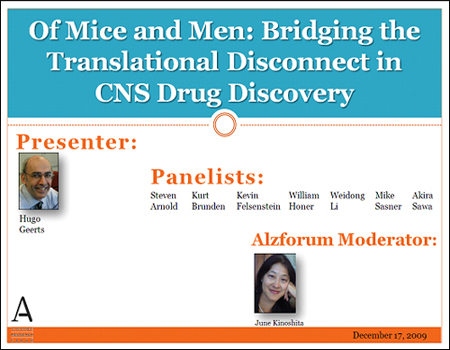Past Webinar
Of Mice and Men: Bridging the Translational Disconnect in CNS Drug Discovery
Quick Links
Introduction
At this Webinar co-hosted by Alzforum and Schizophrenia Research Forum, Hugo Geerts of In Silico Biosciences, presented a talk based on his recent article, "Of Mice and Men: Bridging the Translational Disconnect in CNS Drug Discovery" (CNS Drugs, 2009, November 1). He was joined by invited panelists Steve Arnold, University of Pennsylvania; Kurt Brunden, University of Pennsylvania; Kevin Felsenstein, Envivo Pharmaceuticals; William Honer, University of British Columbia; Weidong Li University of California, Los Angeles; Mike Sasner, Jackson Laboratory; Akira Sawa, Johns Hopkins School of Medicine.
- View/Listen to the Webinar
Click on this image to launch the recording. Webinar slides (PDF) can also be viewed here.
Background
Background Text
Adapted From the CNS Article Abstract
The tremendous advances in transgene animal technology, especially in the area of Alzheimer disease, have not resulted in a significantly better success rate for drugs entering clinical development. Despite substantial increases in research and development budgets, the number of approved drugs in general has not increased, leading to the so-called innovation gap. While animal models have been very useful in documenting the possible pathological mechanisms in many CNS diseases, they are not very predictive in the area of drug development.
Dr. Geerts will report on a number of under-appreciated fundamental differences between animal models and human patients in the context of drug discovery with special emphasis on Alzheimer disease and schizophrenia, such as different affinities of the same drug for human versus rodent target subtypes and the absence of many functional genotypes in animal models. He will also offer a number of possible solutions to bridge the translational disconnect and improve the predictability of preclinical models, such as more emphasis on good-quality translational studies, more pre-competitive information sharing, and the embracing of multi-target pharmacology strategies.
Reengineering the process for drug discovery and development, in a similar way to other, more successful industries, is another possible but disrupting solution to the growing innovation gap. This includes the development of hybrid computational models, based upon documented preclinical physiology and pharmacology, but populated and validated with clinical data from actual patients.
References
Other Citations
External Citations
Further Reading
Papers
- Balin BJ, Gérard HC, Arking EJ, Appelt DM, Branigan PJ, Abrams JT, Whittum-Hudson JA, Hudson AP. Identification and localization of Chlamydia pneumoniae in the Alzheimer's brain. Med Microbiol Immunol. 1998 Jun;187(1):23-42. PubMed.
- Gieffers J, Reusche E, Solbach W, Maass M. Failure to detect Chlamydia pneumoniae in brain sections of Alzheimer's disease patients. J Clin Microbiol. 2000 Feb;38(2):881-2. PubMed.
- Nochlin D, Shaw CM, Campbell LA, Kuo CC. Failure to detect Chlamydia pneumoniae in brain tissues of Alzheimer's disease. Neurology. 1999 Nov 10;53(8):1888. PubMed.
Panelists
-
 Hugo Geerts, Ph.D., Bach. Med., PharmaMBA
Certara
Hugo Geerts, Ph.D., Bach. Med., PharmaMBA
Certara
-
 Kurt Brunden
University of Pennsylvania
Kurt Brunden
University of Pennsylvania
-
 Michael Sasner, Ph.D.
The Jackson Lab
Michael Sasner, Ph.D.
The Jackson Lab
-
 Akira Sawa
Johns Hopkins School of Medicine
Akira Sawa
Johns Hopkins School of Medicine
-
 William Honer, MD, FRCPC
University of British Columbia
William Honer, MD, FRCPC
University of British Columbia
-
 Steven Arnold, MD
Massachusetts General Hospital, Harvard Medical School
Steven Arnold, MD
Massachusetts General Hospital, Harvard Medical School


Comments
No Available Comments
Make a Comment
To make a comment you must login or register.